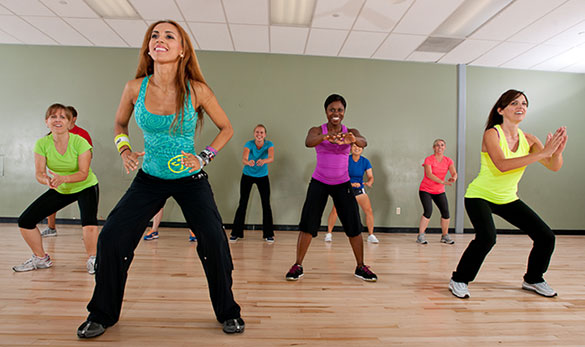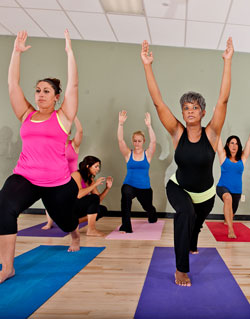Dedicated to all the group exercise instructors out there, including myself :)
Get Inspired! 8 Tips For Group Fitness Instructors

By Amanda Vogel, M.A.
Teaching group fitness can have its ups and downs—from a happy participant in the back row who smiles at you all class long (the ups!) to a technical glitch that leaves you unexpectedly without a mic (total downer). We’ve all been there.
Maximize Your Impact with a Specialty Certification
Whether you are a newly certified Group Fitness Instructor or a seasoned pro, you know that participants demand more than a one-size-fits-all approach. They want specialized knowledge in a wide range of areas, such as mind body, functional training and sports conditioning to help them achieve individual goals. You can effectively meet that demand by pursuing an ACE Specialty Certification. Positioning yourself as a solution to niche markets will not only help you stand out from your competition, it will help you turn your passion for working with specialty populations into greater earning potential. Learn more about the wide range of Specialty Certifications offered by ACE.
This article is full of the kind of inspiration, advice and moral support that any group fitness instructor can appreciate—especially those who are just starting out. Read on for eight expert-tested tips that will help make you a happier, more confident group fitness instructor.Whether you are a newly certified Group Fitness Instructor or a seasoned pro, you know that participants demand more than a one-size-fits-all approach. They want specialized knowledge in a wide range of areas, such as mind body, functional training and sports conditioning to help them achieve individual goals. You can effectively meet that demand by pursuing an ACE Specialty Certification. Positioning yourself as a solution to niche markets will not only help you stand out from your competition, it will help you turn your passion for working with specialty populations into greater earning potential. Learn more about the wide range of Specialty Certifications offered by ACE.
Tip 1: It’s O.K. to Get a Bit Nervous
Most instructors have experienced pre-class jitters, especially when they’re new to a class or format, or new to teaching altogether. Don’t fight your nervous energy—use it to your advantage. “I take nerves as a good sign,” says Alex McLean, a Los Angelesbased senior course instructor for TRX, featured instructor for FitnessGlo and master trainer for multiple fitness brands, including Schwinn Cycling. “It shows how committed I am to the class and the importance of the members.”
“The truth is that I still get nervous before every class I teach, whether it’s a program I am presenting as a master trainer or just my regular Thursday 10:30 a.m. group,” says Carrie Haines, a fitness program consultant and master trainer for BOSU and Tabata Bootcamp in Truckee, Calif., who’s been teaching group exercise for more than 25 years. “The nerves are a sign that you care. Embrace it!”
Still, too much nervousness can easily leave you feeling like a deer caught in the headlights up at the front of the class. Luckily, there are pre-class strategies that can help. “I visualize the class outcome,” says McLean. “I don’t just picture it going well—I see the absolute best!”
Karyn Kattermann’s nerve-busting approach is to be “super prepared” for every class. “I have my music ready to go before I walk into the studio. I have my class plan worked out well in advance. And I always have a Plan B ready in case I had to shift gears unexpectedly.” Kattermann, who lives in Asheville, N.C., is a former group exercise director with 30 years of teaching experience and an advisory board member and Manager of Customer Service and Onboarding at GroupEx PRO, a communication portal for group exercise programs.
Teaching within your comfort zone also helps prevent performance anxiety. “The best way to calm nerves is to know your stuff,” says Haines. “Study, prepare, teach what you are most comfortable with, and use notes. If an exercise is too challenging for you to do, leave it out.”
Tip 2: Love the Formats You Teach

With so many formats on class schedules these days, it can be tough to know whether to be an instructor who can teach pretty much anything, or one that’s deeply familiar with perhaps just one or two formats. Is it better to diversify or specialize?
“As a former group exercise program director, I was always on the hunt for the instructor that could provide the most bang for the buck,” says Kattermann. “I like instructors that have a lot of diversity. That said, not every format is right for every instructor, and I definitely value the ‘subject matter expert’ in any one type of modality.”
“Not everything is going to be in your wheelhouse,” says Haines. “The best advice that I was given as a new instructor was to teach what I felt most confident in. I only teach the programs I feel most connected to and where I feel confident in my own abilities to perform exercises and lead by example.” Simply put, teach what you love to teach.
Tip 3: Who Cares if a Participant Doesn’t Like Your Classes
The vulnerability of standing up in front of a group and sharing your teaching style with a variety of personalities and abilities inevitably means someone won’t like what you have to offer at some point in your teaching career. Every instructor has faced this for the simple fact that you can’t please all the people, all the time.
“No one likes to be disliked,” says Kattermann. “It’s hard because while you can’t take it personally, it is personal. Our classes are our creation.”
Don’t beat yourself up about one critic in the crowd. “Rather than focus on that participant who doesn’t care for your class, reflect on the others who do love it,” says McLean. “Embrace and stay true to your individual brand DNA. [This is] what distinguishes you from others. Continue being you and people will find you!”
While some complaints about your class might feel random—Kattermann points out that sometimes there is no particular reason why someone doesn’t like you—respectful, constructive feedback creates opportunities to improve your teaching. “We sometimes have to just accept that we are not going to wow and win everyone—that’s a given. But we do need to be concerned enough to evaluate why, and be receptive to what we can learn from the person who doesn’t like us, how we can improve, and maybe how to win them over, or accept that we won’t,” says Kattermann.
Tip 4: Most Brand-new Instructors Aren’t Ready to Pack the Room
Group fitness is competitive. Many club owners and fitness managers expect packed classes, but that can be a tall order for instructors who are just finding their footing. Aspiring to fill classes too early in your instructing career is “putting the cart before the horse,” says Haines.
Kattermann seconds that. “New instructors should be learning about leadership, communication, building relationships and teamwork,” she says. “If they can nail all of that, they will pack their classes sooner rather than later. But it does take time. I feel like pressuring a rookie to pack classes is unfair and sets the expectation that numbers are more important than the quality and the experience the instructor is providing.”
That’s not to say class size never matters; it’s relative. “New instructors need to deliver ‘good’ versus ‘packed’ class numbers as determined by the facility,” says McLean. Keep your confidence high by focusing on what’s realistic for your experience level.
Tip 5: It’s O.K. to Give Up a Class
If you’ve ever started to dread teaching one of your regular classes, you’ve likely experienced burnout. While it’s possible to feel burned out from teaching altogether, it can also stem from a certain class, perhaps one you’ve held onto for too long because you love the members and they love you. It can be hard to say goodbye.
Getting past burnout involves first recognizing your lack of enthusiasm for the class and then taking small steps to turn it around if possible. Telltale signs of burnout for McLean include “a continual lack of creativity for choreography and no motivation to teach and/or prep for class.”
Consider whether you can reignite your enthusiasm with continuing education courses and/or a conference. Brainstorm new exercises and/or choreography via relevant YouTube videos or a mobile fitness app. Or join a live class. “I take a class in the same format from another instructor,” says McLean. If none of your “revival” tactics work, remember it’s O.K. to move on. Trust your instinct.
Tip 6: The Popular Instructor’s Teaching Style Might Not Be Yours

Most instructors can point to one or more formal or informal mentors who’ve inspired and influenced them along the way. Looking up to and learning from others is beneficial. Trying to imitate instructor-idols, however, can get tricky. “The big pitfall I’ve experienced myself, and see in rookies, is that they (understandably) try to mimic their favorite instructor,” says Kattermann. But participants pick up on this—why set yourself up for comparisons?
“New instructors need to find their own voice and teaching personality. They need to rely on what they know are their strongest traits,” says Kattermann. If a popular instructor cracks lots of jokes or hams it up, resist following suit unless you truly feel that style fits your personality, as well. Find your personal strengths and bring those to life in your classes—perhaps you are a motivating coach or have a knack for explaining exercise science with simplicity.
Tip 7: When You Speak Less, You Can Coach More
Ever feel that if you’re not talking, you’re not teaching? That’s a misconception. “One common pitfall that newer instructors tend to fall into is over-talking,” says McLean. “It can be uncomfortable to ‘embrace the silence’ and use it as a teaching advantage.”
To practice “embracing the silence,” McLean recommends providing a cue and then taking five deep breaths before you say anything else. “This gives participants time to hear, understand, interpret and then execute,” he says. “It also lets you scan the room to see its impact and decide whether to say the same cue in a different way or address a new coaching point.”
Tip 8: Hold Your Head High and Keep Going
Even the best of the best instructors make mistakes. When experienced instructors go off beat or forget an exercise sequence (or even stumble off the stage!), they can usually laugh it off and seamlessly carry on. Newer instructors might feel mortified if they make these same mistakes. Occasional mess-ups are natural. Do like the pros do and handle them with grace.
Above all, says Kattermann, avoid drawing unnecessary attention to whatever you feel is going wrong. “New instructors spend a lot of time apologizing to the class for mistakes or explaining that they are new,” she says. “I know it comes from a good place, but to a participant, it may seem as if the newbie is asking for a pass to deliver a less than exceptional experience. New instructors do not have to apologize or justify.” It helps to remember that half the class won’t even notice whatever little blunder you think is a big deal.
Teaching group fitness is both rewarding and challenging. Take comfort in knowing that most instructors have been through the ups and downs, too, and have come out on top!
 Amanda Vogel, M.A., is a fitness instructor and presenter in Vancouver, B.C. In addition to being a writer for popular fitness magazines, she is a social media consultant for the fitness industry and a Fitness Technology Spokesperson for IDEA. You can reach her at ActiveVoice.ca, FitnessTestDrive.com (blog), @amandavogel (Twitter), @amandavogelfitness (Instagram) and Facebook.com/FitnessWriter.
Amanda Vogel, M.A., is a fitness instructor and presenter in Vancouver, B.C. In addition to being a writer for popular fitness magazines, she is a social media consultant for the fitness industry and a Fitness Technology Spokesperson for IDEA. You can reach her at ActiveVoice.ca, FitnessTestDrive.com (blog), @amandavogel (Twitter), @amandavogelfitness (Instagram) and Facebook.com/FitnessWriter. 





Thank you very much for writing such an interesting article on this topic. This has really made me think and I hope to read more.weight lifting
ReplyDeleteThis blog is intended to help people understand some of the core principles of training and keeping fit. Thanks for sharing.Group Fitness Trainer Insurance
ReplyDelete